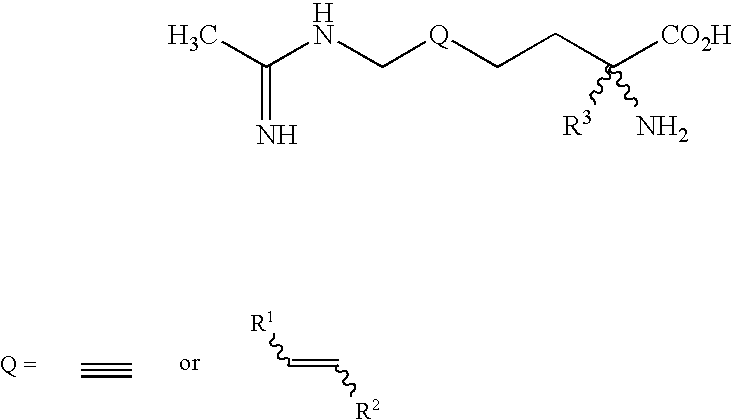2-Amino-2-alkyl-5 heptenoic and heptynoic acid derivatives useful as nitric oxide synthase inhibitors
a technology of heptynoic acid and heptenoic acid, which is applied in the direction of group 3/13 element organic compounds, immunological disorders, metabolism disorders, etc., can solve the problem that imposing conformational rigidity with one or more carbon-carbon double bonds is not a favorable approach to impart selectivity of nos inhibitors
- Summary
- Abstract
- Description
- Claims
- Application Information
AI Technical Summary
Benefits of technology
Problems solved by technology
Method used
Image
Examples
example-1
[0504] To a solution of Example-1A (6.76 g, 24.5 mmol) in 100 mL of methanol at room temperature was added solid NaBH.sub.4 (4.2 g, 220 mmol) in 1.4 g portions over three hours. After 3.5 hours water was added (10 mL). Additional solid NaBH.sub.4 (4.2 g, 220 mmol) was added in 1.4 g portions over three hours. The reaction was quenched with 150 mL of sat. aqueous NU.sub.4Cl and extracted with diethyl ether (2.times.250 mL). The organic layers were combined, dried over MgSO.sub.4, filtered and concentrated. The crude material, 4.81 g of clear oil, was purified by flash column chromatography on silica gel eluting with 10% ethyl acetate in hexane to give 2.39 g (42%) of the desired (2E)-5-[[(1,1-dimethylethyl-)dimethylsilyl]oxy]-2-fluoro-2-penten-1-ol product as a clear oil, that contained an approximate E:Z ratio of 93:7 by .sup.19F NMR.
[0505] HRMS calcd. for C.sub.11H.sub.24FO.sub.2Si: m / z=235.1530 [M+H].sup.+, found: 235.1536. .sup.1H NMR (CDCl.sub.3) .delta.0.06 (s, 6H), 0.88 (s, 9H...
example-1 c
[0507] To a mixture of Example-1B (2.25 g, 9.58 mmol), polymer-supported triphenylphosphine (3 mmol / g, 1.86 g, 15 mmol) and 3-methyl-1,2,4-oxadiazolin-5-one (1.25 g, 12.5 mmol) in 60 mL of TBF was added dropwise diethylazodicarboxylate (2.35 mL, 14.7 mmol). The reaction mixture was stirred for 1 h at room temperature, and additional 3-methyl-1,2,4-oxadiazolin-5-one (0.30 g, 3.0 mmol) was added. After 30 minutes, the mixture was filtered through celite, and the filtrate was concentrated. The resulting yellow oil was triturated with diethyl ether (30 mL) and the solid removed by filtration. The filtrate was concentrated, triturated with hexane (30 mL) and filtered. The filtrates was concentrated to an oil which was purified by flash column chromatography on silica gel eluting with 15% ethyl acetate in hexane to give 1.83 g (60%) of the desired 4-[(2E)-5-[[(1,1-dimethylethyl)dimethyls-ilyl]oxy]-2-fluoro-2-pentenyl]-3-methyl-1,2,4-oxadi-azol-5(4H)-one product as a clear oil, that contai...
example-1d
[0510] A solution of Example-1C (1.83 g, 5.78 mmol) in a mixture of acetic acid (6 mL), THF (2 mL) and water (2 mL) was stirred at room temperature for 2.5 hours. The resulting solution was concentrated in vacuo to an oil which was dissolved in diethyl ether (50 mL). The organic layer was washed with saturated NaHCO.sub.3, and the aqueous layer was extracted with diethyl ether (2.times.50 mL) and ethyl acetate (2.times.50 mL). The combined organic layers were dried (MgSO.sub.4), filtered and evaporated to give 1.15 g (98%) of the desired 4-[(2E)-2-fluoro-5-hydroxy-2-pentenyl-]-3-methyl-1,2,4-oxadiazol-5(4H)-one product as a clear colorless oil.
[0511] HRMS calcd. for C.sub.8H.sub.12FN.sub.2O.sub.3: m / z=203.0832 [M+H].sup.+, found: 203.0822. .sup.1H NMR (CDCl.sub.3) .delta.2.31 (3H), 2.4 (m, 2H), 3.66 (t, 2H), 4.37 (d, 2H), 5.42 (dt, vinyl, 1H). .sup.19F NMR (CDCl.sub.3) .delta.-110.20 (q, 1 F, J=21 Hz). 25
PUM
| Property | Measurement | Unit |
|---|---|---|
| Molar density | aaaaa | aaaaa |
| Molar density | aaaaa | aaaaa |
| Molar density | aaaaa | aaaaa |
Abstract
Description
Claims
Application Information
 Login to View More
Login to View More - R&D
- Intellectual Property
- Life Sciences
- Materials
- Tech Scout
- Unparalleled Data Quality
- Higher Quality Content
- 60% Fewer Hallucinations
Browse by: Latest US Patents, China's latest patents, Technical Efficacy Thesaurus, Application Domain, Technology Topic, Popular Technical Reports.
© 2025 PatSnap. All rights reserved.Legal|Privacy policy|Modern Slavery Act Transparency Statement|Sitemap|About US| Contact US: help@patsnap.com



